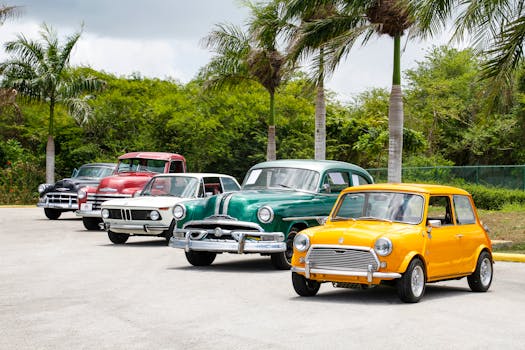Classic Cars Restored to Perfection
For many, classic cars aren't just vehicles; they're a slice of history, embodying an era where design and craftsmanship were paramount. Restoring these beautiful machines to their original splendor is an art, demanding dedication, precision, and a deep respect for automotive heritage. Enthusiasts and collectors globally invest substantial time and resources to revive these timeless beauties, ensuring they remain vibrant pieces of our cultural tapestry.
Restoring classic cars goes beyond mechanical repairs. It's about preserving each vehicle's authenticity and character, often requiring meticulous attention to detail and extensive knowledge of original manufacturing techniques. Whether sourcing rare parts or replicating vintage paint colors, every step in the restoration process is crucial to achieving perfection. This commitment to excellence distinguishes a well-restored classic car from one that merely functions.
In recent years, the market for restored classic cars has grown significantly, driven by both nostalgia and investment potential. High-profile auctions frequently showcase impeccably restored models that fetch impressive prices, highlighting the value placed on these automotive masterpieces. As more people discover the joys of owning a piece of automotive history, the demand for skilled restorers continues to rise. This trend underscores not only the enduring appeal of classic cars but also the craftsmanship involved in their restoration.
The Art of Restoration: Techniques and Challenges
Restoring a classic car is a complex process requiring both technical skills and artistic sensibility. The first step involves thoroughly assessing the vehicle’s condition, identifying areas needing repair or replacement, and determining how best to preserve original components. Restorers often face challenges such as rust damage, outdated electrical systems, and worn-out interiors.
Sourcing authentic parts is another critical aspect. Many classic cars require components no longer in production, necessitating searches at specialty shops, online marketplaces, or even custom fabrication. The goal is always to maintain the car’s originality while ensuring it meets modern safety standards.
The paint job plays a significant role in a car's restoration. Matching the original color can be tricky, especially if the paint codes are obsolete. Experts use advanced techniques like spectrophotometry to analyze paint samples and recreate accurate shades. The final result should be a flawless finish that captures the vehicle's original charm.
Interior restoration demands equal attention. Upholstery must be carefully selected to match historical patterns and materials. From leather seats to wooden dashboards, every detail contributes to an authentic look and feel. It's not just about aesthetics; functionality matters too. Restorers often upgrade wiring systems to support modern conveniences without compromising historical integrity.

The Market for Restored Classics: Trends and Insights
The market for restored classic cars continues to thrive, driven by both enthusiasts and investors. According to Hagerty’s Classic Car Market Index, values have steadily increased over the past decade, reflecting growing interest in these vehicles (Hagerty.com). Auctions like those held by Barrett-Jackson regularly see record-breaking sales for well-restored models.
| Model | Year | Auction Price | Restoration Cost |
|---|---|---|---|
| Ferrari 250 GTO | 1962 | $48 million | $1 million+ |
| Porsche 911 Carrera RS 2.7 | 1973 | $1 million | $200k+ |
| Aston Martin DB5 | 1964 | $6 million | $500k+ |
| Chevrolet Corvette Stingray | 1967 | $3 million | $250k+ |
The increasing prices are not solely driven by nostalgia; restored classics are also seen as sound investments. Unlike new cars that depreciate quickly, well-maintained classics can appreciate over time. This makes them attractive assets for collectors who appreciate both their aesthetic value and financial potential.
The Role of Technology in Restoration Projects
Modern technology has revolutionized the restoration process. Advanced tools like 3D printing allow restorers to create rare parts that are no longer available. Laser scanning helps in precisely measuring components to ensure perfect fits during reassembly.
Drones are increasingly used for detailed inspections of large vehicles or hard-to-reach areas, providing high-resolution imagery that aids in planning restorations more effectively. Software applications help document every phase of the project, ensuring transparency and accuracy throughout.
These technological advancements make it easier to achieve higher levels of precision and quality in restorations while preserving historical authenticity.
Future Outlook: Preserving Automotive Heritage
The future looks bright for classic car restoration as more people recognize the value of preserving automotive heritage. Educational programs focused on teaching restoration skills are gaining popularity, ensuring that future generations can continue this craft.
Sustainability is also becoming a key consideration in restorations. Electric conversions are emerging as an eco-friendly option for classic cars, combining vintage aesthetics with modern green technology (Forbes.com). These innovations promise to keep classic cars relevant in an increasingly environmentally conscious world.
The Timeless Appeal of Classic Cars Restored to Perfection
The restoration of classic cars is more than just a hobby; it's a testament to human ingenuity and passion for preserving history. Each restored vehicle tells a story of its era while showcasing the skills and dedication required to bring it back to life.
As interest in these majestic machines continues to grow, so does appreciation for the meticulous work involved in their restoration. Whether driven by nostalgia or investment potential, restored classic cars remain timeless treasures that connect us with our past while paving the way for future innovations in automotive preservation.